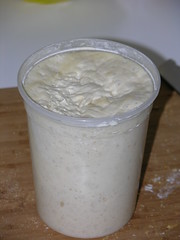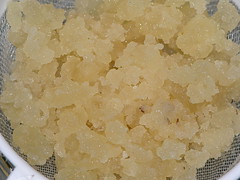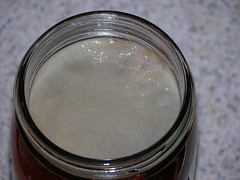It's my newest thing, I am now an offical scobyist. SCOBY stands for a Symbiotic Culture Of Bacteria and Yeast. The term is most often used to describe the culture which ferments kombucha tea, but there are other SCOBYs out there. Kefir grains are SCOBYs, as are sourdough starters. There are counter top yogurt cultures and some cheeses that are cultured using SCOBYs. Each SCOBY type has a different, unique group of yeasts and bacterias. Some great foodstuffs out there are made with SCOBYs and I am trying to do my part to grow and support them!
I have been getting rather serious about breadmaking lately, and I currently have not one but two sourdough cultures going. One is a Russian starter that a generous soul sent me. It has a mild flavor and is fast acting. The other is what I consider a more traditionally American one, with the flavor potential that I think of as typical sourdough. I got it from Carl's Friends and it is an 1847 Oregon Trail starter. Both are giving me great bread and pancakes, which you will be reading more about later. While most folk know that a sourdough starter is a yeast factory of sorts, most still seem unaware that the starters are just as importantly cultures of bacteria that have evolved to cohabit intimately with their given yeasts. The bacteria, in fact, are what give a starter its characteristic flavor and level of sourness, not the yeast. But certain yeasts work best with certain bacteria. It's as delicate a dance of nature as exists between honeybees and lilacs - each supports and protects the other. In many sourdough cultures, the bacteria and yeast eat different and opposing forms of sugars in the grains on which they grow, and some bacteria have been shown to actually produce antibiotics to kill off opposing bacteria that would inhibit not just themselves, but more importantly, their fellow yeasts. We humas can learn a lot from these "simple" lifeforms.
Whereas sourdough SCOBYs generally will appear as thick batter or dough, kefir SCOBYs are small grains. Water kefir grains are translucent, but can absorb color from various liquids used, such as grape juice. They look somewhat like soft edged crystals. Milk kefir grains, on the other hand, are opaque. As they grow, they develop small cauliflower like surface nodules. Whereas sourdough cultures ferment grains (mostly wheat) to raise bread, kefir grains ferment liquids and the sugars in those liquids. Milk kefir is a pleasantly soured milk product made by putting grains in milk until it is fermented. Unlike in breadmaking, the kefir is not cooked, and the nutritional value of the reproducing bacteria is added. Kefir is a natural, probiotic food. It also allows milk, a highly perishable product, to go much longer without refrigeration. It can be substituted for sour cream or buttermilk in baking, and easily replaces ice cream or yogurt in fruit smoothies. I also love to just mix it with applesauce for a refreshing treat, like a thick milkshake.
Water kefir shares many but not all the microorganisms in milk kefir grains. Water kefir grains are added to sugar water, along with dried and/or fresh fruit, to produce a tasty fermented drink. One can get a nice, gently carbonated beverage with some practice. While perhaps not as strong a probiotic as milk kefir, it does have important probiotic value. It also allows for more variety in the finished food product. I personally have been brewing my water kefir with dried apricots, fresh ginger root, fresh lime or lemon slices, and using evaporated organic cane sugar. It comes out as a tarter version of really, really tasty ginger beer and everyone who's tried it has liked it.
The last SCOBY I want to talk about is kombucha. This SCOBY is a rubbery looking and feeling pancake that grows to the size and shape of the container used to ferment it. Not the whole container, mind you! Sweet tea is what it ferments, and the SCOBY floats, sinks, or otherwise hangs out in the tea for at least a week or so. A new SCOBY will grow on the surface of the tea as fermentation proceeds. So the new SCOBY will reflect the size and shape of the top surface area of the tea in your container. The yeasts can grow variously, giving the SCOBY lumps and bumps and discolorations, but sometimes the SCOBY looks very smooth, shiny and off white. The new SCOBY, at the end of fermentation, can be peeled off the original if it is attached, and both can be used to ferment a new batch of sweet tea. The resulting tea is another live, probiotic raw food. After fermentation, komucha tea can be flavored in various manners. Folk differ on how tart or sweet they prefer kombucha tea, and what flavors they prefer, but almost all will enjoy it once they fine tune it to their tastes. It generally sells for $4-6 for a single serving bottle at health stores, so brewing your own is a no brainer.
The wonderful thing about SCOBYs is that, with just a little TLC, they will reproduce infinately, giving us nutritious foodstuffs along their way. And once you get your colony of yeast and bacteria happy, they will reproduce, giving you SCOBYs to share with loved ones.
Subscribe to:
Post Comments (Atom)






3 comments:
This is cool!
whether the difference between kefir and yogurt?
Which is better between them?
whether kefir has the same flavor of yogurt?
Kefir has more probiotic activity than yogurt, and is more tart in flavor. Kefir is usually thinner than commercial yogurts, which have all sorts of chemical fillers in them to thicken them. With kefir you simply put the kefir grains in milk and let it sit at room temperature to ferment, but yogurt has to be cooked over a steady temperature. Homemade, both are great and are simply different products with different tastes. Hope that helps!
Post a Comment